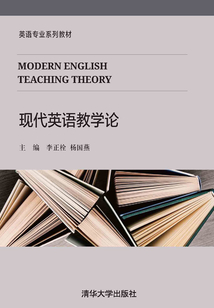舉報(bào) 

會(huì)員
現(xiàn)代英語(yǔ)教學(xué)論
最新章節(jié):
“中國(guó)學(xué)生發(fā)展核心素養(yǎng)”總體框架
本書(shū)基于《英語(yǔ)課程保準(zhǔn)》(實(shí)驗(yàn)稿)和教育部提出的“中國(guó)學(xué)生發(fā)展核心素養(yǎng)”,旨在培養(yǎng)當(dāng)前我國(guó)師范畢業(yè)生的教學(xué)意識(shí)、教學(xué)方法,啟發(fā)他們的教學(xué)思路。本書(shū)共分為十八個(gè)章節(jié),涉及中國(guó)英語(yǔ)教學(xué)的發(fā)展歷程、交際原則、體驗(yàn)學(xué)習(xí)、任務(wù)型教學(xué)、自主學(xué)習(xí)、教案設(shè)計(jì)、多智能教學(xué)策略等內(nèi)容。既適用于英語(yǔ)專(zhuān)業(yè)師范生和基礎(chǔ)教育一線英語(yǔ)教師,又為備考英語(yǔ)教師資格證書(shū)的考生提供學(xué)習(xí)與參考。
最新章節(jié)
- “中國(guó)學(xué)生發(fā)展核心素養(yǎng)”總體框架
- Appendix II Core Qualities for Chinese Students’ Development
- IV. Special terms on language teaching theory
- III. Special terms used in ETM
- II. Subjects concerning ETM
- I. Main schools of ETM
品牌:清華大學(xué)
上架時(shí)間:2019-12-06 15:09:14
出版社:清華大學(xué)出版社
本書(shū)數(shù)字版權(quán)由清華大學(xué)提供,并由其授權(quán)上海閱文信息技術(shù)有限公司制作發(fā)行
- “中國(guó)學(xué)生發(fā)展核心素養(yǎng)”總體框架 更新時(shí)間:2019-12-06 16:35:01
- Appendix II Core Qualities for Chinese Students’ Development
- IV. Special terms on language teaching theory
- III. Special terms used in ETM
- II. Subjects concerning ETM
- I. Main schools of ETM
- Appendix I Glossary
- Bibliography
- Discussion
- Processes of Creating Assessment Portfolio
- Assessment of Students’ Language Proficiency
- Types of Test Items
- Practical Steps to Test Construction
- Principles for Designing Effective Classroom Tests
- Principles of Classroom Assessment and Evaluation
- Classification of Tests
- Criteria for Measuring a Test
- Test Measurement Evaluation and Assessment
- Chapter 18 Assessment of Language Proficiency
- Discussion
- Problems of Using Technology in Language Teaching
- Multimedia-Assisted Language Teaching
- Teaching with Video
- Computer-Assisted Language Learning (CALL)
- The Language Laboratory
- Technology in the Language Classroom
- Why to Use Technology in Language Teaching
- Chapter 17 Technology and Language Teaching
- Discussion
- Action Research Case Study
- Components of the Report
- Guidelines for Conducting Action Research
- Methods and Techniques for Action Research
- How to Choose Your Research Topic
- Steps in Action Research
- Aims of Action Research
- Characteristics of Action Research
- Defining Action Research
- Chapter 16 Action Research
- Discussion
- Effective Ways of Promoting Greater Learner Independence and Autonomy
- Teacher’s Role
- Learning Styles and Strategies
- How to Help Learners in Autonomy
- The Autonomous Learner
- Principles for Fostering Autonomy in the Language Classroom
- Defining Autonomy
- Chapter 15 Learner Autonomy in the Language Classroom
- Discussion
- Exemplification
- Learning Activities for Multiple Intelligences
- Multiple Intelligence Tool Box
- Stages in Teaching with Intelligences
- Other Intelligences
- Key Points in Applying Multiple Intelligences
- Theory of Multiple Intelligences
- Classification of Multiple Intelligences
- Definition of Multiple Intelligences
- Chapter 14 Multiple Intelligences and English Language Teaching
- Discussion
- Communicative Activities
- More Suggestions on Language Teaching Techniques
- Techniques and Skills of English Language Teaching
- Using Pictures in Classroom
- Using Games in Classroom
- Classroom Activities
- Tasks
- Chapter 13 Teaching Skills and Classroom Activities
- Discussion
- What If Some Students-in-groups Finish Before Everybody Else?
- What If Students Don’t Want to Talk?
- What If Students Are Uncooperative?
- What If Students Keep Using Their Own Language?
- What If the Class Is Very Big?
- What If Students Are All at Different Levels?
- Reacting to Problem Behavior
- Preventing Problem Behavior
- Chapter 12 Tips for Solving Classroom Problems
- Discussion
- Teacher Feedback
- The Six Levels of the Taxonomy on Questioning
- The Seven Habits of Highly Effective Questioners
- What Do We Know About Questioning?
- The Importance of Classroom Questions
- Chapter 11 Questioning Skills
- Discussion
- Self-evaluation
- Evaluation of a Teacher’s Lesson
- Correction of Mistakes
- Using Teaching Aids
- Discipline in the Language Classroom
- Troubleshooting
- Patterns of Classroom Interaction
- Routines of a Lesson
- Chapter 10 Classroom Management
- Discussion
- Component of a Lesson Plan
- The Principles for a Lesson Plan
- Some Incomplete Plans
- Five Parts of a Lesson or Unit Plan
- Attention to Concept Maps of the Lesson Plan
- Importance of Instructional Planning
- Chapter 9 Instructional Planning
- Discussion
- Two Major Activities That Can Motivate Interaction
- Developing Questioning Techniques for Interactive Learning
- Roles of the Interactive Teacher
- Interactive Principles
- Defining Interaction
- Chapter 8 Interactive Language Teaching
- Discussion
- Assessment of Inquiry Learning
- Application of Inquiry Learning
- Developing Students’ Questioning Skills in Inquiry Learning
- Strategies of Inquiry Learning
- Significance and Objectives of Inquiry Learning
- Characteristics of Inquiry Learning
- Definition of Inquiry Learning
- Chapter 7 Inquiry Learning
- Discussion
- Planning a Text-Based Task Lesson
- Designing Text-Based Tasks
- Defining Text-Based Tasks
- Starting Points for Tasks
- Roles of Learner and Teacher
- Types of Learning Activities
- The Practice of Tasks and Skills
- Features of Task-Based Learning
- Goals and Outcomes in Task-Based Instruction
- Defining Tasks
- Chapter 6 Task-Based Language Teaching
- Discussion
- Reflection and Motivation in Experiential Learning
- Settings in Experiential Learning
- Characteristics of Experiential Learning
- Basic Model of Experiential Learning
- Foundations of Experiential Learning
- Role of Experience in Learning
- Implications of Experiential Learning
- Chapter 5 Experiential Learning
- Discussion
- The Lexical Approach
- Theme-Based Instruction
- Content-Based Instruction
- Cooperative and Collaborative Learning
- Neurolinguistic Programming
- Whole Language Education
- Chapter 4 Alternatives of Communicative Approach
- Discussion
- Suggestions
- Excuses for Avoiding Communicative Approach in English Classes
- Impact of Communicative Approach on English Language Teaching in China
- Comparison Between Audio-Lingual Method and Communicative Approach
- Designing Communicative Activities
- Techniques of Communicative Approach
- Teacher’s Role in Communicative Approach
- Objectives of Communicative Approach
- Caveats of Communicative Approach
- Characteristics of Communicative Approach
- Theory of Communicative Approach
- Development of Communicative Approach
- Chapter 3 Communicative Approach
- Discussion
- Other Teaching Methods Influencing English Language Teaching (ELT) in China
- Cognitive Approach
- Natural Approach
- Oral Approach and Audio-Lingual Method
- Grammar-Translation Method and Direct Method
- Chapter 2 A Historical Overview of English Language Teaching Methodology in China
- Discussion
- Main Performance of Development of Learners’ Core Qualities
- Basic Connotation of Learners’ Core Qualities
- The Importance of Development of Core Qualities
- Performance Standards for Different Levels of Competence
- Objectives Structure in the National English Curriculum (2001)
- Introduction to the National English Curriculum
- Chapter 1 The National English Curriculum and Development of Learners’Core Qualities
- 前言
- 內(nèi)容簡(jiǎn)介
- 版權(quán)信息
- 書(shū)名頁(yè)
- 封面
- 封面
- 書(shū)名頁(yè)
- 版權(quán)信息
- 內(nèi)容簡(jiǎn)介
- 前言
- Chapter 1 The National English Curriculum and Development of Learners’Core Qualities
- Introduction to the National English Curriculum
- Objectives Structure in the National English Curriculum (2001)
- Performance Standards for Different Levels of Competence
- The Importance of Development of Core Qualities
- Basic Connotation of Learners’ Core Qualities
- Main Performance of Development of Learners’ Core Qualities
- Discussion
- Chapter 2 A Historical Overview of English Language Teaching Methodology in China
- Grammar-Translation Method and Direct Method
- Oral Approach and Audio-Lingual Method
- Natural Approach
- Cognitive Approach
- Other Teaching Methods Influencing English Language Teaching (ELT) in China
- Discussion
- Chapter 3 Communicative Approach
- Development of Communicative Approach
- Theory of Communicative Approach
- Characteristics of Communicative Approach
- Caveats of Communicative Approach
- Objectives of Communicative Approach
- Teacher’s Role in Communicative Approach
- Techniques of Communicative Approach
- Designing Communicative Activities
- Comparison Between Audio-Lingual Method and Communicative Approach
- Impact of Communicative Approach on English Language Teaching in China
- Excuses for Avoiding Communicative Approach in English Classes
- Suggestions
- Discussion
- Chapter 4 Alternatives of Communicative Approach
- Whole Language Education
- Neurolinguistic Programming
- Cooperative and Collaborative Learning
- Content-Based Instruction
- Theme-Based Instruction
- The Lexical Approach
- Discussion
- Chapter 5 Experiential Learning
- Implications of Experiential Learning
- Role of Experience in Learning
- Foundations of Experiential Learning
- Basic Model of Experiential Learning
- Characteristics of Experiential Learning
- Settings in Experiential Learning
- Reflection and Motivation in Experiential Learning
- Discussion
- Chapter 6 Task-Based Language Teaching
- Defining Tasks
- Goals and Outcomes in Task-Based Instruction
- Features of Task-Based Learning
- The Practice of Tasks and Skills
- Types of Learning Activities
- Roles of Learner and Teacher
- Starting Points for Tasks
- Defining Text-Based Tasks
- Designing Text-Based Tasks
- Planning a Text-Based Task Lesson
- Discussion
- Chapter 7 Inquiry Learning
- Definition of Inquiry Learning
- Characteristics of Inquiry Learning
- Significance and Objectives of Inquiry Learning
- Strategies of Inquiry Learning
- Developing Students’ Questioning Skills in Inquiry Learning
- Application of Inquiry Learning
- Assessment of Inquiry Learning
- Discussion
- Chapter 8 Interactive Language Teaching
- Defining Interaction
- Interactive Principles
- Roles of the Interactive Teacher
- Developing Questioning Techniques for Interactive Learning
- Two Major Activities That Can Motivate Interaction
- Discussion
- Chapter 9 Instructional Planning
- Importance of Instructional Planning
- Attention to Concept Maps of the Lesson Plan
- Five Parts of a Lesson or Unit Plan
- Some Incomplete Plans
- The Principles for a Lesson Plan
- Component of a Lesson Plan
- Discussion
- Chapter 10 Classroom Management
- Routines of a Lesson
- Patterns of Classroom Interaction
- Troubleshooting
- Discipline in the Language Classroom
- Using Teaching Aids
- Correction of Mistakes
- Evaluation of a Teacher’s Lesson
- Self-evaluation
- Discussion
- Chapter 11 Questioning Skills
- The Importance of Classroom Questions
- What Do We Know About Questioning?
- The Seven Habits of Highly Effective Questioners
- The Six Levels of the Taxonomy on Questioning
- Teacher Feedback
- Discussion
- Chapter 12 Tips for Solving Classroom Problems
- Preventing Problem Behavior
- Reacting to Problem Behavior
- What If Students Are All at Different Levels?
- What If the Class Is Very Big?
- What If Students Keep Using Their Own Language?
- What If Students Are Uncooperative?
- What If Students Don’t Want to Talk?
- What If Some Students-in-groups Finish Before Everybody Else?
- Discussion
- Chapter 13 Teaching Skills and Classroom Activities
- Tasks
- Classroom Activities
- Using Games in Classroom
- Using Pictures in Classroom
- Techniques and Skills of English Language Teaching
- More Suggestions on Language Teaching Techniques
- Communicative Activities
- Discussion
- Chapter 14 Multiple Intelligences and English Language Teaching
- Definition of Multiple Intelligences
- Classification of Multiple Intelligences
- Theory of Multiple Intelligences
- Key Points in Applying Multiple Intelligences
- Other Intelligences
- Stages in Teaching with Intelligences
- Multiple Intelligence Tool Box
- Learning Activities for Multiple Intelligences
- Exemplification
- Discussion
- Chapter 15 Learner Autonomy in the Language Classroom
- Defining Autonomy
- Principles for Fostering Autonomy in the Language Classroom
- The Autonomous Learner
- How to Help Learners in Autonomy
- Learning Styles and Strategies
- Teacher’s Role
- Effective Ways of Promoting Greater Learner Independence and Autonomy
- Discussion
- Chapter 16 Action Research
- Defining Action Research
- Characteristics of Action Research
- Aims of Action Research
- Steps in Action Research
- How to Choose Your Research Topic
- Methods and Techniques for Action Research
- Guidelines for Conducting Action Research
- Components of the Report
- Action Research Case Study
- Discussion
- Chapter 17 Technology and Language Teaching
- Why to Use Technology in Language Teaching
- Technology in the Language Classroom
- The Language Laboratory
- Computer-Assisted Language Learning (CALL)
- Teaching with Video
- Multimedia-Assisted Language Teaching
- Problems of Using Technology in Language Teaching
- Discussion
- Chapter 18 Assessment of Language Proficiency
- Test Measurement Evaluation and Assessment
- Criteria for Measuring a Test
- Classification of Tests
- Principles of Classroom Assessment and Evaluation
- Principles for Designing Effective Classroom Tests
- Practical Steps to Test Construction
- Types of Test Items
- Assessment of Students’ Language Proficiency
- Processes of Creating Assessment Portfolio
- Discussion
- Bibliography
- Appendix I Glossary
- I. Main schools of ETM
- II. Subjects concerning ETM
- III. Special terms used in ETM
- IV. Special terms on language teaching theory
- Appendix II Core Qualities for Chinese Students’ Development
- “中國(guó)學(xué)生發(fā)展核心素養(yǎng)”總體框架 更新時(shí)間:2019-12-06 16:35:01
作者還寫(xiě)過(guò)
同類(lèi)熱門(mén)書(shū)


